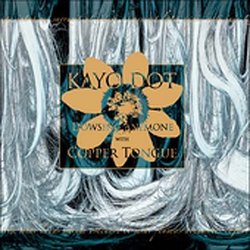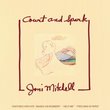| All Artists: Kayo Dot Title: Dowsing Anemone with Copper Tongue Members Wishing: 0 Total Copies: 0 Label: Robotic Empire Original Release Date: 1/1/2006 Re-Release Date: 1/10/2006 Genres: Alternative Rock, Special Interest, Rock, Metal Styles: Hardcore & Punk, Experimental Music, Progressive, Progressive Rock, Alternative Metal, Death Metal Number of Discs: 1 SwapaCD Credits: 1 UPC: 790168532429 |
Search - Kayo Dot :: Dowsing Anemone with Copper Tongue
 | Kayo Dot Dowsing Anemone with Copper Tongue Genres: Alternative Rock, Special Interest, Rock, Metal
|
Larger Image |
CD DetailsSimilarly Requested CDs
|
CD ReviewsWonderful music. Lord Chimp | Monkey World | 05/14/2006 (5 out of 5 stars) "This is a very special band with a lot to share. In hindsight it is obvious from the first Kayo Dot that the band's past "astral metal" incarnation, maudlin of the Well, was not meant to be any point of reference.* The curiously titled _Dowsing Anemone with Copper Tongue_ a fortiori severs the connection to that lovable, obscure band. For one thing, although the instrumental lineup has not changed significantly (guitars, piano/keys, violin, trumpet, drums & percussion, with electronics), the music is virtually bereft of anything I would call metal or prog-rock (or whatever exactly motW was). The vocals turned farther away from the screaming and roaring and more towards schizophrenic and dreamy. The music is much more texturally and melodically based than riff-based, and the music is highly composed. If I may have the liberty of comparison, it sounds a little like an obsessed mutant child of Neurosis, GYBE, and a drugged-up Jeff Buckley, still informed by rock, jazz, classical, and ambient. All the while its structural approach reveals less favor for the Western convention of contrasting sections -- the songs of _Dowsing Anemone..._, most of which being 10 to 15 minutes-plus in length, are slowly-evolving, organic constructions. One must hear it to understand how unique and special this music is. It begins rather like the first album. "Gemini Becoming Tripod", the first track, sets the album up with its lengthy, spacious arrangements, more 'natural' sound, and otherworldly intimations. It starts with a repetitive, harmonically static guitar being strummed with a more fluid violin accompaniment. This combination is whipped into a tumult then fades away as plaintive vocals and weird lyrics like "Geometry showed me its dark side and showered me with its arcing planes" emerge, delivered with tortured, incomprehensible moaning from Driver, which is beaten around by well-timedstrikes of distorted guitars, reaching through a Gorguts-esque apogee with chaotic violin lines and a squealing guitar solo. And that is only the first song! Then, "Immortelle and Paper Caravelle" could be the post-rock ballad to send lovers everywhere into crazier fits of ardor than Amando and Amanda from Ligeti's great opera _Le grand macabre_. It begins with a seemingly random sparkle of heavily-reverbed guitar notes, gradually given cohesion by the introduction of senuous bass lines and a jazzy drum rhythm. Toby Driver's falsetto vocals, the words totally unintelligible, are so delicate he must be hovering between a state of life and death. He sings some of the most perfect melodic lines recorded before a transition of multi-tracked violin pizzicatos and a simple guitar riff leaves the song to fade out in a blissful web of strings and effects. This beautiful slice of music, which is almost absurdly pretty, set against Kayo Dot's apocalyptic climax on "___ on Limpid Form", suggests a disturbing nonchalance about the clash of doom and beauty. But that's always been a theme of Toby Driver's bands... "Aura on an Asylum Wall" jerks one out of the dreamy state induced by the previous piece. It starts in a dull cacophony of interlocking pieces of eerie glissandos and drunken half-talking/half-singing. It takes a weird vaudevillian twist with a 9/8 rhythm and trumpet solo, then it almost seems to imperceptibly change as thrusts of sustained tones appear and disappear over a steadily intensifying rhythm speckled with violin flourishes. The guitars start to sound more riff-like until it all explodes in a rash grind of crackling distortion over frantic screaming with really surprising, fast n' funky bass by Ryan McGuire and a crazy percussion track that sounds like it was put together with traditional tape-splicing. "___ on Limpid Form" starts almost in verse-chorus mode, low, plaintive vocal harmonies singing of "a soundless rapture that dissolves the form." Jazzy horn solos and the weird rhythm make it seem like some kind of underwater fugue. Starting at about 4:50 or 5:00, the song takes a dark and disturbing turn. What starts as a handful of chromatic chords punctuated by tense silences, become more spaced apart, more distorted, and more crushing, until 10 minutes later when it is just slow, periodic strikes of heavily detuned chords from the book of Sunn 0))), each capped by a brutal squeal of feedback and surrounded by mechanical junkyard percussion. When the roaring distortion of "___ on Limpid Form" rolls over into "Amaranth the Peddler", one is humbled by Kayo Dot's masterful resolution. It starts with a very quiet introduction for solo drums rather like "The Ferryman" from motW's _Bath_. It is joined by irregular bassy grumbles that expand and contract for a few minutes before strange, overlapping whistling noises and violins that sound like pitch-bending sirens enter the soundscape. The instrumentation that concludes is complex, arpeggiated chord playing which wafts like an autumn wind through dry leaves. "Amaranth" is an incredibly haunting, strange piece and it ends the album PERFECTLY. _Dowsing Anemone in Copper Tongue_ is only the second album under the Kayo Dot banner, and so perfect and brilliant that the band may never surpass it. * if you are at all interested in progressive rock/metal or original music of any kind you must do yourself a favor and hear everything by maudlin of the Well." Sublime Reverend_Maynard | Glasgow, United Kingdom | 07/12/2006 (5 out of 5 stars) "Impossibly, Kayo dot combine disonnance, delectable melody, heavy metal flourishes, avant-garde excursions and post rock dynamics into a whole which is never sprawling-it seems focused, tuned, intended and overwhelmingly, and most importantly, it feels _right_ and _good_. The first track for instance, starts off much as Marathon from _Choirs_, but twists and turns in an almost imperceptible way into a somehow perfect, extended break which sees Toby Driver emitting some bizzare, unsettling screams and practically wordless vocals....yet when the full force of the instruments, his vision and the chord structure collapses on top of his anguished 'Gemiminiiiiiii' everything is dragged, impossibly, right into place. '_On Limpid Form' is a nightmarish journey, descending into SunnO)))-ish repeated chords driven home with the force and inevitability of continental drift-yet when this shift is juxtaposed and infiltrated by scattering, schizophrenic percussion, the near 10 minute wait to reach this point takes on new meaning. The point of this journey is not to arrive. So violins, guitars, trumpets, and, importantly, Drivers frighteningly versatile voice may seem to be battling it out for primacy in a messy and baffling blend of insanity, but KD works like Tool-everything is positioned and nothing is wasted. Ok, this review is pretentious and not entirely coherent, but the point I wanted to get across most-that this album is odd and difficult, unique, yet impossibly, overwhelmingly, it feels _right_, is what I would like you to take from it. Driver never ceases to amaze me. With this record, he doesnt just push the envelope, he stamps on it, sets it on fire and shoots it out a big cannon into The Sun. Pretty much the future of music, or at least the music I want to listen to. Buy buy buy!" It's about as experimental as you can get and still appear o Aquarius Records | San Francisco | 02/05/2006 (5 out of 5 stars) "Hot on the heels of the excellent "solo" album from Kayo Dot frontman Toby Driver we reviewed earlier, comes this new opus from Kayo Dot proper. They've moved from Tzadik to metalcore label Robotic Empire, but Dowsing Anemone With Copper Tongue is no less avant-garde than previous KD output, that's for sure (you ought to be able to tell that just by the title, eh?).
A confusing, crushing blend of Godspeed, Neurosis, John Zorn, Amber Asylum, Oxbow... Kayo Dot's apparent points of reference make for a mysterious listen. It's chamber-prog rock, it's metal, it's melodic and mysterious, with cryptic lyrics softly intoned amidst the creepy, ambient beauty, marred (not really) by violent outbursts of claustophobic heaviness, when and if the track builds to such a climax... Or marred by jazzy saxophone solos, there's that too. You can tell why John Zorn likes 'em! Actually, sax only surfaces significantly on "Aura On An Asylum Wall" which also has some of the album's most brutal blasting passages to make up for all that jazziness. There's also rumbling percussion and droning strings and sensitive singing and long stretches of ominous, dark, weighty quietude -- track lengths reach up to 18 minutes and are often more soundscapey than anything "song-structured". It's about as experimental as you can get and still appear on a nominally "metal" label." |

 Track Listings (5) - Disc #1
Track Listings (5) - Disc #1



